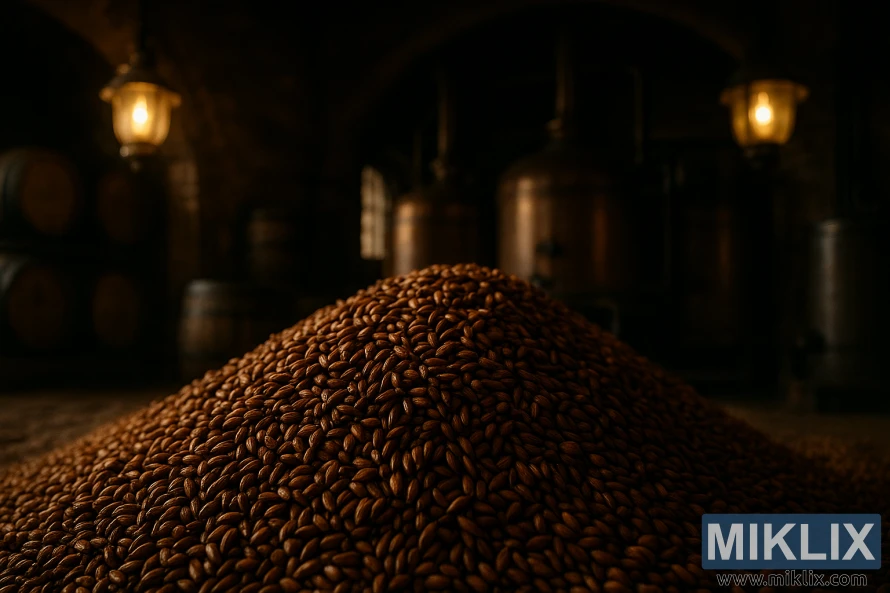Image: Mild ale malt in historic brewhouse
Published: July 22, 2025 at 9:36:39 PM UTC
Last updated: September 27, 2025 at 3:38:01 PM UTC
Freshly kilned mild ale malt glows amber in a historic brewhouse, surrounded by oak barrels and golden lamp light, evoking tradition and artisanal brewing.
In the hushed interior of a historic brewhouse, the scene unfolds like a reverent tribute to the timeless craft of ale making. The space is dimly lit, not with shadows of neglect, but with the warm, golden glow of antique gas lamps that flicker softly against the aged brick walls and timber beams. Their light spills across the room in gentle pools, illuminating the textures of wood, metal, and grain with a painterly touch. At the heart of this atmospheric setting lies a generous pile of freshly kilned mild ale malt, its deep amber kernels forming a mound that seems to radiate warmth and promise.
The malted barley grains, rich in color and character, are arranged with a sense of purpose. Their smooth, elongated forms glisten subtly under the ambient light, revealing hints of reddish-brown and golden undertones that speak to the careful kilning process they’ve undergone. The aroma, though invisible, seems to permeate the air—earthy, toasted, and faintly sweet, evoking memories of hearth fires and harvest festivals. This is not just an ingredient; it is the soul of the ale, the foundation upon which flavor, body, and tradition are built.
Captured from a low angle, the composition elevates the malt both literally and symbolically. It dominates the foreground, drawing the viewer’s eye and anchoring the narrative in the raw material that defines the brew. Behind it, rows of oak barrels stand in quiet formation, their curved staves darkened with age and use. Some are stacked horizontally on wooden racks, others upright on the stone floor, each one a vessel of transformation. These barrels, used for aging and conditioning, lend depth and complexity to the final product, infusing it with subtle notes of vanilla, spice, and time itself.
Further back, copper brewing tanks glint softly in the lantern light, their rounded forms and riveted seams hinting at decades of service. Pipes and valves snake along the walls, connecting vessels in a silent choreography of heat, pressure, and flow. The brewhouse hums with quiet energy, a place where science and art converge, where every batch is a dialogue between grain and brewer, between past and present.
The overall ambiance is steeped in nostalgia, yet it feels alive and purposeful. The warm lighting, the aged materials, and the careful arrangement of tools and ingredients all speak to a philosophy of brewing that values patience, precision, and respect for tradition. The mild ale malt, with its mellow sweetness and subtle complexity, is perfectly suited to this environment. It’s a grain that doesn’t overpower but enriches, that lends body and warmth without demanding attention—an ideal choice for brewers seeking balance and depth.
This image is more than a snapshot of a brewing space; it’s a portrait of legacy. It invites the viewer to imagine the hands that have worked here, the recipes passed down, the quiet satisfaction of a well-crafted pint. It celebrates the tactile beauty of malt, the architectural grace of the brewhouse, and the enduring appeal of ale made with care and conviction. In this quiet, amber-lit moment, the essence of traditional brewing is not just seen—it’s felt.
The image is related to: Brewing Beer with Mild Ale Malt

